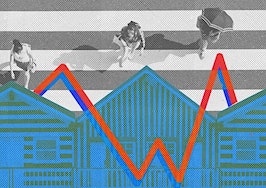Lew Sichelman is a seasoned writer with 50 years of covering the housing and mortgage markets under his belt. His biweekly Inman column publishes on Tuesdays.
At an anticipated cost of $892 million, including a fixed translucent roof, the proposed ballpark in Ybor City, Florida, for the Tampa Bay Rays baseball team would have just 28,216 seats, making it the smallest in the major leagues. But the stadium looms large for housing in the area, according to a report issued a couple of years ago.
The jury is still out on whether new sports stadiums are economic engines for their communities, which often pay some or all of the costs for new sports facilities. In the Rays’ case, the team would pay only half the price tag, with the remainder coming from Tampa, Hillsborough County and other sources.
But the 2016 study by Tex-X, a commercial real estate platform that allows buyers, sellers and real estate professionals to search, list and transact properties totally online, shows that when it comes to housing alone, new stadiums can be big winners.
The research, which has not been updated, found that the sales of houses within close proximity — 3 miles to 6 miles — to 12 professional sports team stadiums announced in the 25-year span between 1990 and 2015 outpaced the overall metropolitan markets 80 percent of the time.
Once the stadiums were opened, sales in the immediate areas were 70 percent above that of the entire metro area. The results were strikingly more modest for price gains, but nearby population growth was significant.

Rick Sharga
Then Ten-X Executive Vice President, Rick Sharga, stressed at the time that the study is not an attempt to discuss the merits of how stadiums are financed, which is the major bone of contention between proponents of public financing and those who are opposed to it.
“It’s just a real estate study on the performance of housing markets,” he said.
The Irvine, California-based company undertook the study when staffers during an internal meeting wondered what the impact of the new home planned for the Los Angeles Rams football team in nearby Inglewood would have on the local real estate market.
Set to open in 2020, the Rams new home is being built a few miles from downtown LA on a 300-acre site. At $2.6 billion, it is expected to be the worlds’s most expensive sports arena.
Only time will tell what will happen around the as-yet unnamed facility. But Sharga said he expected the same big spike in sales that was found in other markets.

Matthew Shreck
In half the dozen stadiums covered in the report, prices in their immediate areas grew at a greater percentage than they did for the entire metro area. In the rest, values still grew but not at as great a rate as the overall market, Matthew Shreck, a quantitative strategist at Ten-X, told me.
At the same time, populations in the immediate vicinity of stadiums studied grew 26 percent above the outer metro area after they were opened, Schreck said.
Overall, Schreck wrote in a company blog, “supply and demand growth responded positively in a vast majority of cases.”
For example, the opening of Barclays Center “coincided with the height of Brooklyn’s ongoing revitalization,” the Tex-X analyst noted. And there are still half-a-dozen cranes surrounding the new ballpark for the Washington Nationals baseball club in Southeast D.C. several years after it opened, signaling the ongoing renaissance in the once blighted section of the nation’s capital.
Of course, it also helps when the teams occupying the stadiums are highly ranked in their respective sports. In those cases, the study found that nearby housing sales are likely to be stronger than if the teams are perennial losers.
Take, for example, Petco Park, the downtown home of the lowly San Diego Padres baseball team, an architectural gem which opened in 2004 and immediately became known as “America’s Best Ballpark.”
In the five-year period after the stadium was announced in 2004, the volume of homes sold within a 3-mile radius was 295 percent greater than for the city as a whole. Even after Petco opened, sales in the vicinity were 116 percent greater than for the entire city, Tex-X found.
Population around the ballpark also blossomed 31 percent between 2000 and 2010. Over the same period, the San Diego metro area’s population grew by just 11 percent.
At the same time, though, house prices near the field dipped 33 percent, whereas values in the entire San Diego market were down 206 percent.
Local market conditions also play a big role in the study’s findings, Sharga told me when the report was released. He ventured that the glut of downtown San Diego condominiums during the study period probably had an impact on pricing.
The neighborhoods within a 3-mile radius of Nissan Stadium in Nashville, the home of football’s Tennessee Titans, showed even more activity than those in San Diego. Sales were 412 percent greater in the stadium area in the five-year period after the stadium was announced in 1995 than the overall Nashville market.
Sales slowed considerable after Nissan opened in 1999, but they were still 12 percent greater than the larger market in the following five-year period. During that same period, prices and population around the stadium outpaced the entire market by 12 percent and 13 percent, respectively.
The other stadiums covered in the Tex-X report area:
- Baseball’s Marlins Park, Miami
- Baseball’s AT&T Park, San Francisco
- Baseball’s Chase Field, Phoenix
- Baseball’s Miller Park, Milwaukee
- Basketball’s Barclays Center, Brooklyn
- Football’s University of Phoenix Stadium, Phoenix
- Baseball’s Ford Field, Detroit
- Football’s Bank of America Stadium, Charlotte
- Football’s M&T Bank Stadium, Baltimore
- Football’s Levi Stadium, San Francisco
Lew Sichelman is a seasoned writer with 50 years of covering the housing and mortgage markets under his belt. His biweekly Inman column publishes on Tuesdays.







